
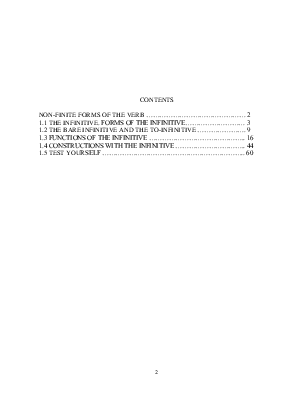





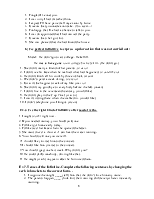
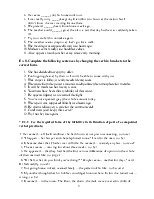



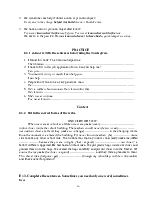



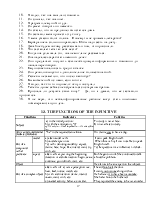

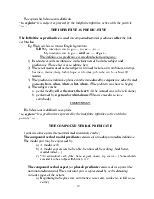









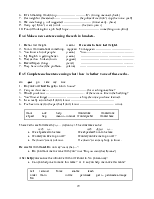


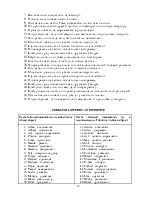














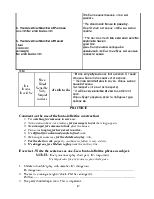













МИНИСТЕРСТВО ОБРАЗОВАНИЯ РЕСПУБЛИКИ БЕЛАРУСЬ
ЛИНГВОГУМАНИТАРНЫЙ КОЛЛЕДЖ УЧРЕЖДЕНИЯ ОБРАЗОВАНИЯ
«МИНСКИЙ ГОСУДАРСТВЕННЫЙ ЛИНГВИСТИЧЕСКИЙ УНИВЕРСИТЕТ»
НЕЛИЧНЫЕ ФОРМЫ ГЛАГОЛА
ИНФИНИТИВ
ДИСЦИПЛИНА
«ПРАКТИЧЕСКАЯ ГРАММАТИКА»
Минск, 2007
CONTENTS
NON-FINITE FORMS OF THE VERB ……………………………………… 2
1.1 THE INFINITIVE. FORMS OF THE INFINITIVE……………………… 3
1.2 THE BARE INFINITIVE AND THE TO-INFINITIVE …………………. 9
1.3 FUNCTIONS OF THE INFINITIVE …………………………………….. 16
1.4 CONSTRUCTIONS WITH THE INFINITIVE ………………………….. 44
1.5 TEST YOURSELF ……………………………………………………….. 60
NON-FINITE FORMS OF THE VERB
(VERBALS)
Nonfinite forms of the verb do not limit the verb to a particular number, tense, person or mood and do not function as predicates. In other words, they cannot make sentences they form only word-combinations: the money borrowed in the bank, the idea of promoting Mr Smith, etc. These forms are also called Verbals because they are made from the verb.
The function of Nonfinite forms of the verb is to complicate sentences adding another verbal structure to the finite one:
Verbal Predicate
The money borrowed in thebank provides basic finance.
The ideaof promoting Mr. Smith belonged to the manager.
The above sentences are formally simple as they have only one finite verb (Predicate), but logically there are two ideas that are joined in one sentence:
E.g. The money borrowed in the bank provides basic finance.
The money was borrowed in the bank. The money provides basic finance.
There are four Verbals in the English language: the Infinitive, the Gerund, Participle I and Participle II, two of which - the Gerund and Participle I - coincide in the form:
|
The infinitive |
The Gerund |
Participle I |
Participle II |
|
Do write |
Doing writing |
Doing writing |
Done written |
The Verbals also have voice, aspect and perfect distinctions and they fulfill different functions, consistent with different parts of speech such as the noun, the adjective, and the adverb.
All non-finite verb forms may participate in so –called predicative constructions, where the noun (or pronoun) and a verbal are in predicative relations similar to those of the subject and the predicate:
Eg. I heard Jane singing. We waited for the train to pass. I saw him run.
* Finite forms of the verb are the ones that have a particular number, tense, person or mood and their function in sentences is to be a predicate. In other words, Finite forms of the verb make sentences:
The money provides basic finance. It was borrowed in the bank.
Mr. Smith was promoted. The idea belonged to the manager.
THE INFINITIVE
1. 1 The infinitiveis a non-finite form of the verb which names a process in a most general way. It is treated as the initial form of the verb, which represents the verb in the dictionaries.
The infinitive can be:
a) used with the particle “to” (the full infinitive/to-infinitive);
b) used without the particle “to” (the bare infinitive);
c) separated with the particle “to” by an adverb (the split infinitive eg. She doesn’t want to even see him). It is used very seldom to give special emphasis to the verb.
The infinitive has a double nature: it combines the features of the verb and the noun.
The nominal features are only syntactical. Like a noun the Infinitive can be used as
1. subject: Never to study at night was her rule.
2. predicative: Judy’s intention was to become a writer.
3. object: Judy was sorry to leave the farm.
The verbal features of the infinitive are of two kinds:
a) Morphological: (like the verb) the infinitive has the category of voice, perfect, aspect.
Eg. to do -Active Voice, to be done - Passive voice;
To do – Non-perfect, to have done – Perfect;
To do – Common(Indefinite), to be doing – Continuous (Progressive).
b) Syntactical: the infinitive possesses the verb combinability (takes an object, can be modified by an adverb)
Eg. I promise never to do such a mistake again. (direct object)
I can do this job perfectly. (an adverb)
1.1 FORMS OF THE INFINITIVE
There are several forms of the Infinitivein English: Indefinite, Continuous, Perfect and Perfect Continuous which are used to show both the simultaneousness or the priority of the action of the Infinitiveto the main verb andthe form's aspect. Some of them have Passive forms:
|
Active |
Passive |
|
|
Indefinite |
to speak |
to be spoken |
|
Continuous |
to be speaking |
|
|
Perfect |
to have spoken |
To have been spoken |
|
Perfect Continuous |
to have been speaking |
Table A
The verb tenses corresponding to the tenses of the infinitive are as follows:
|
Verb tenses |
Infinitive |
|
|
Present simple Future simple |
He works He will work |
-to work |
|
Present Continuous Future Continuous |
He is working He will be working |
-to be working |
|
Past simple Present Perfect Past Perfect Future perfect |
He worked He has worked He had worked He will have worked |
-to have worked |
|
Past Continuous Present Perfect Continuous Past Perfect Continuous Future perfect Continuous |
He was working He has been working He had been working He will have been working |
-to have been working |
Table B
The Indefinite Infinitive expresses an action simultaneous with that of the finite verb, so it may refer to the present, past or future;
I'm glad to meet you.
I was glad to see her.
I'll be glad to come
It's glorious to love and to be loved.
There is no time to lose. = There is no time to be lost.
The Continuous Infinitive expresses an action simultaneous with that of the finite verb, but this is an action in progress:
They happened to be standing near a small restaurant.
The Perfect Infinitive expresses
1) an action prior to that of the finite verb:
I'm glad to have seen you.
2) a prior action that was not carried out:
I meant to have gone there. (But I didn't go there).
The Perfect Continuous Infinitive expresses the action which lasted a certain time before the action of the finite verb
She seemed to have been eating nothing for ten days.
PRACTICE
Ex. 1 Define noun and verbal characteristics of the infinitive. State the form of the infinitive.
Model: She promised to write letters regularly.
“to write” is the Indefinite Infinitive Active. As a noun it is used in the function of an object. As a verb it takes a direct object (letters) and is modified by an adverb (regularly).
1. Mr. Gordon began to breathe heavily. 2. The Farrells like to tell jokes. 3. “She must have been combing her hair,” she said, “when they came for her.” 4. I haven’t meant to scold and don’t expect to be scolded. 5. He demanded to be taken to see the baby. 6. Could you ask him to come as soon as he can? 7. To hear him talk is an education in itself. 8. There’s nothing to be done with her. 9. I think we ought to be starting. 10. I cannot imagine why you should ever have been prevented from seeing the baby. 11. Jimmie tells me he is prepared to sign the statement. 12. They must be intending to go for a swim. 13. You might have thought of Miguel. 14. Our task is to master English.
Ex. 2 Comment on the forms of the infinitives. Translate the sentences.
1. He seems to be playing tennis now. 2. Carol didn't want to bother anyone, and she didn't want to be bothered. 3. I'm sorry to have done it. 4. She heard him open the door. 5. What has made her leave us so soon? 6. If you think it is necessary to make changes, you must choose
Уважаемый посетитель!
Чтобы распечатать файл, скачайте его (в формате Word).
Ссылка на скачивание - внизу страницы.